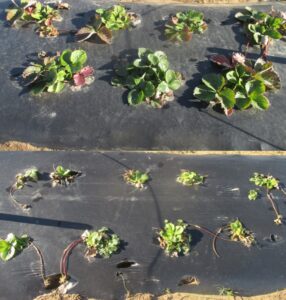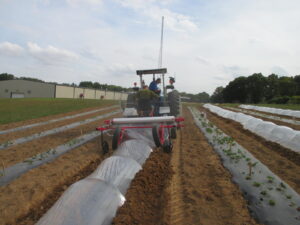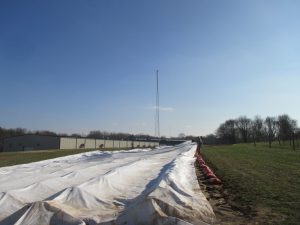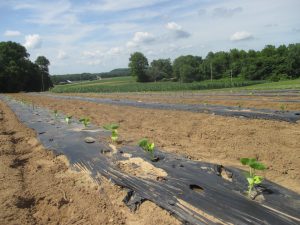Strawberries are primarily grown in matted row system in Indiana, in which bare-root strawberry plants are set in the spring. Runners are established. Fruit is first harvested in the second year and plantings are renovated each year for 2-3 seasons. Growers in the southern part of the state expressed interest in growing strawberries in plasticulture system, in which plants are set on raised beds covered with plastic mulch. Strawberries may be planted in fall with plug plants, or in summer with bare-root plants. Runners are removed. Fruit is harvested the following year from mother plants.
Using plug plants is more feasible for large-scale production as plants can be set with a transplanter and water wheel. However, plug plants are typically not available until the end of Aug. The growing window is often short in the fall so that it is difficult for the plants to develop enough branch crowns. As a result, yield in the following spring is often unsatisfactory; hard to justify production cost.
We have been testing the plasticulture strawberry production system at the Southwest Purdue Ag Center in Vincennes, IN thanks to supporting from a Purdue AgSEED grant and a Rice grant. In order to increase heat accumulation, we used high tunnel and low tunnel systems. Although we are far from coming to a conclusion about the production system, our preliminary studies did show promising results. In this article, I will discuss the results of using low tunnels to increase strawberry yield.
The experiment was conducted in 2019-2020 season with ten strawberry cultivars. Plug plants were planted on Sep. 10. Low tunnels were installed in half of the field with a mechanical transplanter low tunnel layer on Oct. 10 . The low tunnel layer set hoops 4.5’ apart, and covered with 1 mil perforated clear plastic (Figure 1). The low tunnel plastic was removed on Jan. 2. The field was covered with floating row covers for a short period in Nov., and for most of the time in Jan. and Feb (Figure 2). In spring, floating row covers were also used to protect flowers against the freeze damage in Apr. and May. Harvest started around May 10, and lasted for about a month.
The highest yield cultivar was Liz under low tunnels (0.84 lb/plant) (Figure 3), followed by Camarosa under low tunnels (0.77 lb/plant). Chandler under low tunnels had the third-highest yield (0.61 lb/plant). The other cultivars grown under low tunnels had significantly lower yields compared to the top-yielding cultivars.

Figure 3. Cultivar Liz growing with (top) and without (bottom) low tunnel. Photo was taken on Jan 2 after low tunnel was removed.
Without low tunnels, most cultivars had lower yield compared with the same cultivar with low tunnels, except ‘Beauty’ (a day-neutral cultivar) that yielded higher without low tunnels; and ‘Radiance’ that yielded similar with and without low tunnels. The yield was generally very low without low tunnels (ranged from 0.27 -0.59 lbs/plant), and no significant difference among cultivars.
The past strawberry production season was full of challenges. It was no exception for our trial. Deer visited the field shortly after planting. Although low tunnels effectively stopped the damage, deer had cleaned most leaves of the newly planted plug plants prior to setup of the low tunnels. This damage dramatically delayed plant growth in Sep. An unusually cold event happened in middle Nov. that dragged temperatures to single digits at SWPAC. In April and May, we encountered late frosts. Although the frost damage was minimized by using floating row covers, a small percentage of primary flowers were killed when temperatures dropped below 30°F on April 16.
After harvest, the plants may be kept for another year for a second-year harvest. But labor required to remove runners from summer to fall in the second year can be overwhelming. As runner removing has to be conducted by hand at this stage, it may not be feasible for large-scale production. In addition, weeds in row middles, and pest control in the summer can also be challenges.
Double cropping, use the same plastic for a second crop, is an alternative approach. Since planting the second crop may not be possible until the end of June; pumpkin, winter squash, and brassica crops (broccoli, cauliflower, cabbage, etc.) are the most promising second crop. In our trials, we planted kabocha squash on the same plastic after strawberry on July 1. Things are looking great at this point. We are expecting to harvest the squash in another month.
The experiment is continuing in the 2020-2021 season at SWPAC. Hopefully, after a few seasons, we will have a solid idea of the feasibility of the production system, and generate economic data to help growers make decisions. Please stay tuned for the additional update of strawberry research at SWAPC.


